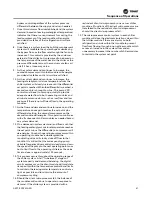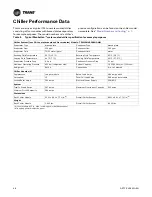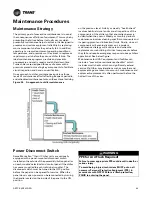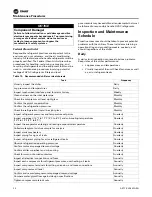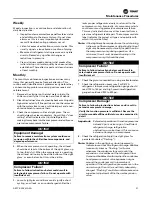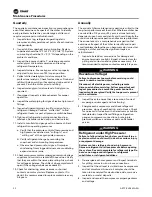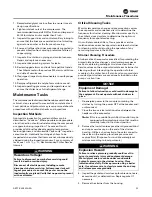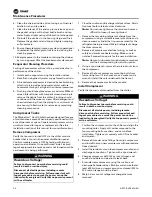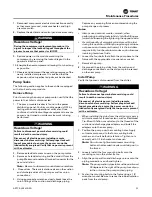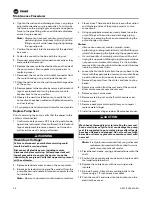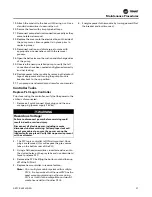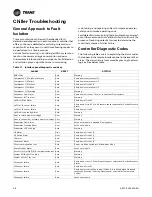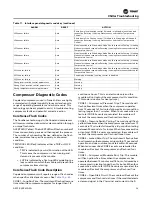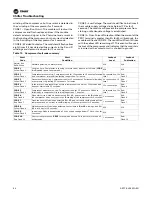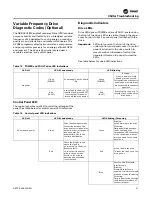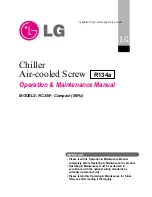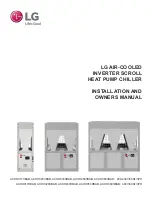
46
ARTC-SVX002A-EN
Sequence of Operations
This manual describes a typical water-cooled chiller
system with few, if any, optional components or devices
attached. To cover the primary difference in construction
and operation, two sequences of operation are included;
one for a constant flow chiller system and the other for a
variable flow chiller system.
Constant Flow Sequence
1. The chiller operates with high voltage power supplied
to the unit at all times.
2. The client microprocessor controller selects a new lead
module and rotates this lead once every 168 hours, or
once a week.
3. The chiller system is enabled when the system ON/OFF
switch on the touchscreen interface panel is energized,
and the remote start/stop relay is enabled, either
through a contact closure or via the BMS.
4. For systems with a tank and pump module, when the
chiller is enabled, the lead chiller pump energizes. If the
flow switch in the tank and pump module closes within
the delay period, the primary pump continues to
operate. Should the primary pump fail to start or to
close the flow switch within the time delay period, this
pump will be shut down, and the secondary pump
activates. An alarm signal sounds on the
microprocessor controller indicating primary pump
failure.
5. Once flow is established and the system demand
(based on leaving water temperature) indicates that
there is a requirement for cooling, the lead compressor
of the lead module will energize provided all safeties
on that circuit are satisfied.
6. As the system demand increases, the first compressor
of the first server module will energize provided all
safeties on that circuit are satisfied.
7. As the system demand increases, the leaving water
temperature from the chiller will slowly increase until
the differential set point is reached (set point plus 4 °F
(2 °C)). When the differential is reached, a third
compressor from the second server module (or if there
is only one server module, the second compressor of
the lead module) will be brought on-line.
8. As the demand continues to increase, and the
temperature once again reaches the set point plus
differential setting, a fourth compressor from the third
server module (or the second compressor of the first
server if there is only one server) will be brought on
line.
9. On a decrease in system demand such that the leaving
water temperature reaches the set point minus the
differential (set point minus 1 °F (0.5 °C)), a compressor
will de-energize in the reverse of the sequence by
which it came on.
10. This process occurs throughout the operating range of
the chiller.
11. The microprocessor will rotate to designate a new lead
module once a week to equalize the run time among
the modules.
12. A three-way condenser water-regulating valve can be
provided to maintain chiller head pressure when the
condenser water temperature is below 65 °F (18 °C).
The regulating valve bypasses cold water from the
condensers to the condenser water return line while
allowing sufficient water to the condensers to maintain
head pressure.
13. Alternatively, for a water-cooled chiller with a two-way
condenser water-regulating valve, the valve
modulates to allow sufficient water to the condensers
to maintain head pressure when the condenser water
temperature falls below 65 °F (18 °C).
Variable Flow Sequence
1. The chiller is designed to operate with high voltage
power supplied to the unit at all times.
2. As long as there is power on the system, the electronic
valve in the client module will open to allow flow
through the entire chiller system.
3. The chiller system is enabled when the system on-off
switch on the touchscreen interface panel is energized,
and the remote start/stop relay is enabled either
through a contact closure or via the BMS.
4. When the system is enabled, the chiller pump (if
provided by Trane) will energize. If the differential
pressure switch within the tank and pump module
closes within the time delay period, the primary pump
continues to operate. Should the primary pump fail to
start or close the differential pressure switch within the
time delay period, this pump will de-energize, and the
secondary pump will activate. An alarm signal is
generated providing an indication of primary pump
failure on the microprocessor controller.
5. The variable frequency drive (VFD) for the chiller
pumps are provided and installed by Trane. The
control signal for each VFD is provided from the
microprocessor in the tank and pump module. The
pump speed is synchronized with the number of
chillers that are operating on the system.
6. The electronic isolation valve of the client lead chiller
identified in step 2 is already energized. Therefore, the
system pump must produce the minimum flow
required by the lead chiller. A system bypass must be
provided by the customer and installed external of the
chiller to assure that the pump can provide the
minimum flow required through the lead chiller. (A
high-quality pressure-independent valve is
recommended for this bypass to provide accurate
















